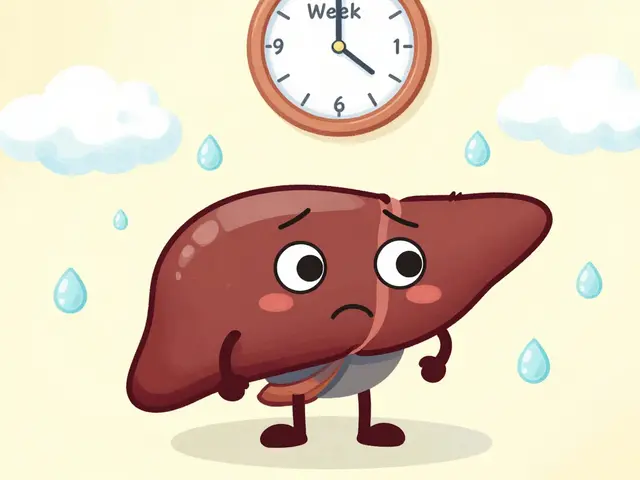Atenolol is a cardioselective beta‑blocker prescribed to lower blood pressure and control heart rhythm. While it’s great for the heart, some people notice breathing issues after starting the drug. This guide explains why that happens, who should watch out, and how to manage the problem without abandoning your heart health.
Quick Takeaways
- Atenolol blocks beta‑1 receptors but can still affect beta‑2 receptors in the lungs.
- People with asthma or COPD are most vulnerable to shortness of breath and wheezing.
- Reducing dose, switching to a more selective blocker, or adding a rescue inhaler often resolves symptoms.
- Never stop the medication without consulting a clinician.
- Regular medication reviews can catch breathing side‑effects early.
How Atenolol Works - The Cardiovascular Angle
Beta‑blockers bind to beta‑adrenergic receptors, preventing adrenaline from speeding up the heart. Atenolol preferentially blocks the β1 subtype found mostly in cardiac tissue, lowering heart rate and contractility. This reduction eases blood pressure and reduces the workload on a failing heart.
Why Breathing Issues Can Appear
Beta‑blocker is a class of drugs that inhibit beta‑adrenergic receptors throughout the body. Even though atenolol is billed as “cardioselective,” it isn’t 100% exclusive to β1 receptors. At higher doses, the drug can spill over and block β2 receptors located in bronchial smooth muscle. When β2 receptors are inhibited, the airways can tighten - a process called bronchoconstriction, defined as narrowing of the airways due to smooth‑muscle contraction. The result is that some patients feel shortness of breath, develop wheeze, or notice a dip in their peak flow readings.
Who Is Most at Risk?
The lungs already rely heavily on β2‑mediated relaxation. Conditions that compromise airway calibre make any additional β2 block more noticeable.
- Asthma is a chronic inflammatory disease characterized by reversible airway obstruction and hyper‑responsiveness. Even mild asthma can flare when β2 pathways are blunted.
- COPD is a group of progressive lung diseases, including emphysema and chronic bronchitis, that cause persistent airflow limitation. COPD patients often have a reduced baseline lung function, so any extra constriction feels significant.
- Elderly patients frequently have reduced β2 receptor reserve and may be on multiple medications that affect breathing.
In practice, a pulmonologist or primary‑care physician will flag any history of asthma, COPD, or unexplained dyspnea before starting a beta‑blocker.
Spotting the Symptoms Early
Typical respiratory signals include:
- Sudden onset of shortness of breath, described as a feeling of not getting enough air.
- Wheezing - a high‑pitched whistling sound on exhalation.
- Decrease in pulmonary function test results, especially forced expiratory volume in one second (FEV1).
Because these signs can also stem from heart failure, it’s crucial to differentiate cardiac‑related dyspnea from drug‑induced bronchoconstriction. A quick peak‑flow measurement can help; a drop of more than 10% after starting atenolol warrants a medication review.

Managing Breathing Side‑Effects
When respiratory symptoms appear, clinicians usually follow a step‑wise approach:
- Confirm the link. Review timing - symptoms often start within days to weeks of dose escalation.
- Adjust the dose. Lowering atenolol by 25% often restores β2 activity without compromising blood‑pressure control.
- Switch to a more β1‑selective agent. Drugs such as metoprolol have higher β1 affinity and lower respiratory risk.
- Add or optimise inhaled therapy. A short‑acting bronchodilator (e.g., albuterol) can offset transient bronchoconstriction.
- Conduct a medication review. Identify other drugs that may worsen breathing, such as non‑selective beta‑blockers or high‑dose aspirin.
Patients should never discontinue atenolol abruptly, as sudden withdrawal can trigger rebound tachycardia or hypertension.
Comparison: Atenolol vs. Metoprolol (Respiratory Safety)
| Attribute | Atenolol | Metoprolol |
|---|---|---|
| β1 : β2 selectivity ratio | ~ 150 : 1 | ~ 200 : 1 |
| Incidence of bronchoconstriction (clinical reports) | 2-4% | 1-2% |
| Typical oral dose range (mg) | 25-100 | 25-200 |
| Renal clearance (% of dose) | ~ 50% | ~ 30% |
| Recommended for asthmatics (guideline) | Use with caution | Preferable if needed |
Both drugs are cardioselective, but metoprolol’s higher β1 affinity translates into a marginally lower risk of respiratory side‑effects. Nevertheless, individual response varies, so trial and monitoring remain essential.
Related Concepts Worth Knowing
Understanding the broader landscape helps you have an informed conversation with your prescriber.
- Cardioselective beta‑blocker is a beta‑blocker that preferentially blocks β1 receptors over β2 receptors, aiming to spare the lungs.
- Drug interaction refers to any change in a drug’s effect caused by another medication, supplement, or food. For example, combining non‑selective beta‑blockers with bronchodilators can blunt the latter’s efficacy.
- Medication review is a systematic evaluation of a patient’s drug regimen to improve safety, effectiveness, and adherence. It’s the best place to raise breathing concerns.
- Peak flow monitoring provides a quick, at‑home measurement of maximum airflow, useful for spotting early bronchoconstriction.
- Understanding the difference between short‑acting and long‑acting inhalers can empower you to control symptoms while staying on needed cardiac medication.
Next Steps for Patients and Caregivers
If you or a loved one is on atenolol and notice any breathing change, follow this simple checklist:
- Record when the symptom started and any recent dose changes.
- Measure peak flow if you have a device; note any drop.
- Contact your prescriber - describe the timing, severity, and any asthma/COPD history.
- Ask whether a dose reduction, switch to metoprolol, or a trial of inhaled bronchodilator is appropriate.
- Schedule a follow‑up within 1-2 weeks to reassess blood pressure and lung function.
Being proactive saves you from unnecessary hospital visits and ensures your heart stays protected.
Frequently Asked Questions
Can atenolol cause asthma attacks?
Atenolol can worsen asthma symptoms by mildly blocking β2 receptors, especially at higher doses. It rarely triggers a full‑blown attack in well‑controlled asthma, but anyone with a history should be monitored closely.
Is metoprolol a safer alternative for people with COPD?
Metoprolol’s higher β1 selectivity gives it a slightly lower risk of bronchoconstriction. Many clinicians prefer it for COPD patients, but the choice still depends on individual response and overall cardiovascular goals.
Should I stop atenolol if I feel shortness of breath?
No. Stopping abruptly can cause rebound high blood pressure and heart rate spikes. Instead, contact your doctor to discuss dose adjustment or a medication switch.
How long does it take for breathing symptoms to improve after changing the dose?
Most patients notice improvement within 24‑48hours after a dose reduction or switch. Full normalisation of lung function may take up to a week, depending on underlying lung disease.
Are there any non‑drug ways to protect my lungs while on atenolol?
Yes. Regular aerobic exercise improves overall lung capacity, avoiding smoking, using air purifiers during high‑pollution days, and keeping a peak‑flow meter handy can all help you catch early changes.






18 Comments
Been on atenolol for 3 years and never had an issue, but my cousin with asthma started it last month and was wheezing by day 3. She switched to metoprolol and it’s like night and day. Don’t let anyone tell you it’s ‘just in your head’-this stuff is real.
So let me get this straight-Big Pharma’s been pushing beta-blockers that *literally choke your lungs* because they’re cheaper than actual heart meds? And we’re supposed to be grateful it’s ‘cardioselective’? 😂
Next they’ll tell us aspirin ‘mostly’ doesn’t cause internal bleeding. Wake up, sheeple.
I’m a respiratory therapist in rural Ohio and I see this all the time. Elderly patients on atenolol come in with ‘sudden asthma’-but they’ve never had asthma before. It’s the drug. I’ve had to explain to 12 patients this year that their ‘new’ breathing problem started the week they got the script. One woman cried because she thought she was dying. She wasn’t. She just needed a switch to metoprolol and a rescue inhaler. It’s not complicated, but doctors don’t always connect the dots. I wish more people knew about peak flow meters. They’re $20 at CVS and could save your life. Also, if you’re on this med and you smoke? Stop. Please. Your lungs are already fighting a war, and now they’re being bombed from the inside.
wait so if you have copd and take atenolol… you just… get more short of breath? like, even if you’re not active? i’m kinda scared now bc my dad’s on it and he’s always tired… i thought it was just aging 😅
OMG I’m so glad someone finally said this. I’ve been screaming into the void for months that my cardiologist ignored my wheezing. I’m a 42-year-old woman who runs marathons-why would I suddenly get asthma?! Turns out, it wasn’t asthma. It was atenolol. I cried when I read the label. I felt so stupid for not pushing harder. Now I’m on metoprolol and my peak flow is back to normal. If you’re reading this and you’re on atenolol and feel like you’re suffocating? Don’t wait. Go back. Demand a switch. You’re not being dramatic. Your lungs matter.
While the article presents a clinically sound overview, the implicit assumption that β1 selectivity is sufficient to mitigate respiratory risk is statistically misleading. The incidence figures cited (2–4% for atenolol vs. 1–2% for metoprolol) are derived from retrospective cohorts with significant confounding variables, including concomitant medication use and baseline pulmonary reserve. A prospective, double-blind RCT would be necessary to validate the purported safety differential. Furthermore, the omission of pharmacokinetic variability-particularly in renally impaired patients-is a critical oversight. The recommendation to ‘reduce dose’ lacks granularity: a 25% reduction in a 100mg dose yields 75mg, which may still exceed the β2-blocking threshold in sensitive individuals. Clinical guidance must be more precise.
My grandma’s on atenolol and she’s been breathing funny since last winter. I didn’t think much of it-she’s 82, right? But then I read this and realized… maybe it’s not ‘just old age.’ She’s got COPD, but she’s never needed an inhaler before. Now she’s using her albuterol three times a day. I’m taking her to her doc next week to ask about metoprolol. I’m so glad this exists. Thank you for writing it. 🌿
Hey I’m on atenolol too and I get wheezy after I work out. Is that normal? Should I stop running? 😬
YASSS THIS IS SO IMPORTANT!! 🙌 I had no idea my shortness of breath was from the med! I thought I was just out of shape. Switched to metoprolol and now I can climb stairs again 😭❤️
Also, if you’re on this, get a peak flow meter. It’s like a fitness tracker for your lungs. 💨📊
AMERICA IS BEING POISONED BY BIG PHARMA. They know atenolol causes breathing death but they don’t care because it’s cheap. Why not just give us inhalers and call it a day? NO! They want us dependent on pills that kill slowly. This is genocide by prescription. 🇺🇸💀
You got this! 🙌 If you’re feeling weird with your breathing on atenolol, don’t panic-just talk to your doc. I was scared too when I started it, but we lowered my dose and added a rescue inhaler. Now I’m stronger than ever. Your heart and lungs can both be protected. You’re not alone!
My brother’s a cardiologist and he always says, ‘If the patient says their lungs feel tight after starting a beta-blocker, believe them.’ No one wants to be told they’re ‘just anxious.’ I’ve seen people get misdiagnosed with asthma when it was the med. It’s so easy to fix-just switch or adjust. Why don’t more doctors think of this first? Maybe because they’re rushed. But it’s worth the 5 minutes. Your lungs are part of your heart’s team.
It is noteworthy that the pharmacodynamic profile of atenolol, particularly its renal excretion, renders it less suitable for elderly patients with diminished glomerular filtration rates. Accumulation may lead to prolonged β2 receptor blockade, even at standard doses. Clinical vigilance is advised in this demographic, irrespective of prior pulmonary history.
While the article provides a comprehensive overview, it does not adequately address the potential for drug-drug interactions with non-selective beta-blockers or NSAIDs, which may exacerbate bronchoconstriction. Additionally, the absence of a discussion regarding genetic polymorphisms in β2-adrenergic receptors, which may predispose certain individuals to heightened sensitivity, represents a significant gap in the clinical context presented.
As someone from India who’s seen both allopathic and Ayurvedic approaches, I can tell you-this isn’t just a Western problem. We have a huge population on beta-blockers here too, and no one talks about breathing. My uncle had COPD and was on atenolol for hypertension. He was wheezing so bad he couldn’t sleep. His doctor said, ‘It’s just the COPD getting worse.’ I dug into papers and found this exact thing. We switched him to metoprolol and gave him a nebulizer. He’s breathing again. The system here doesn’t train doctors on this. Patients have to be their own advocates. And honestly? It’s exhausting. But if you’re reading this, you’re already ahead. Don’t stop asking questions. Your breath is sacred. Don’t let a pill steal it.
The data presented is accurate but lacks context on patient compliance. Many patients do not report mild dyspnea due to fear of medication discontinuation. Furthermore, the distinction between ‘wheezing’ and ‘dyspnea’ is often conflated in self-reports, leading to potential overestimation of respiratory side effects. A more granular symptom taxonomy would improve clinical accuracy.
I’ve been on atenolol for 7 years and never had an issue-until last year, when I started hiking more. Suddenly, I couldn’t catch my breath on trails. I thought I was getting old. Then I read this. I went to my doctor, we switched me to metoprolol, and now I’m back on the trails. Don’t give up on your meds-just find the right one. Your heart and lungs are both worth fighting for. Keep moving. Keep breathing. 💪❤️
Thank you for writing this. I’ve been afraid to say anything because I didn’t want to seem like I was complaining. But my breathing has been off since I started atenolol. I’m going to my appointment tomorrow with this printed out. I deserve to breathe well, even while protecting my heart.